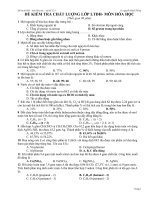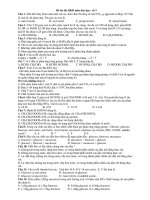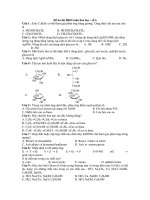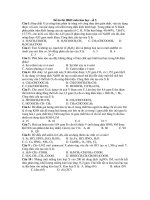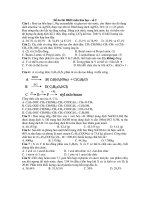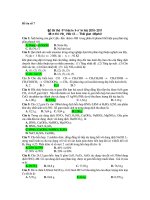Đề ôn thi thử môn hóa (775)
Bạn đang xem bản rút gọn của tài liệu. Xem và tải ngay bản đầy đủ của tài liệu tại đây (183.84 KB, 5 trang )
e3
93. Malik AN, Czajka A. Is mitochondrial DNA content a potential
biomarker of mitochondrial dysfunction? Mitochondrion. 2013;13:
481-492.
94. Simmons JD, Lee YL, Mulekar S, et al. Elevated levels of plasma
mitochondrial DNA DAMPs are linked to clinical outcome in
severely injured human subjects. Ann Surg. 2013;258:591-596,
discussion 596-598.
95. Kilbaugh TJ, Lvova M, Karlsson M, et al. Peripheral Blood Mitochondrial DNA as a Biomarker of Cerebral Mitochondrial Dysfunction following Traumatic Brain Injury in a Porcine Model.
PLoS One. 2015;10(6):e0130927.
96. Viscomi C, Bottani E, Zeviani M. Emerging concepts in the therapy
of mitochondrial disease. Biochim Biophys Acta 2015;1847:544-557
97. Berger MM, Chiolero RL. Antioxidant supplementation in sepsis
and systemic inflammatory response syndrome. Crit Care Med.
2007;35(suppl 9):S584-S590.
98. Galley HF. Bench-to-bedside review: targeting antioxidants to mitochondria in sepsis. Crit Care. 2010;14:230.
99. von Dessauer B, Bongain J, Molina V, Quilodrán J, Castillo R,
Rodrigo R. Oxidative stress as a novel target in pediatric sepsis
management. J Crit Care. 2011;26(1):103.e1-e7.
100. Szeto HH. Mitochondria-targeted cytoprotective peptides for ischemia-reperfusion injury. Antioxid Redox Signal. 2008;10:601-619.
101. van den Berghe G, Wouters P, Weekers F, et al. Intensive insulin
therapy in critically ill patients. N Engl J Med. 2001;345:1359-1367.
102. Macrae D, Tasker RC, Elbourne D. A trial of hyperglycemic control
in pediatric intensive care. N Engl J Med. 2014;370:1355-1356.
103. Agus MS, Steil GM, Wypij D, et al. Tight glycemic control versus
standard care after pediatric cardiac surgery. N Engl J Med. 2012;
367:1208-1219.
104. Stump CS, Short KR, Bigelow ML, Schimke JM, Nair KS. Effect
of insulin on human skeletal muscle mitochondrial ATP production, protein synthesis, and mRNA transcripts. Proc Natl Acad Sci
USA. 2003;100:7996-8001.
105. Vanhorebeek I, De Vos R, Mesotten D, Wouters PJ, De WolfPeeters C, Van den Berghe G. Protection of hepatocyte mitochondrial ultrastructure and function by strict blood glucose control
with insulin in critically ill patients. Lancet. 2005;365:53-59.
106. Ferreira FL, Ladriere L, Vincent JL, Malaisse WJ. Prolongation of
survival time by infusion of succinic acid dimethyl ester in a caecal
ligation and perforation model of sepsis. Horm Metab Res. 2000;32:
335-336.
107. Kilbaugh TJ, Bhandare S, Lorom DH, Saraswati M, Robertson CL,
Margulies SS. Cyclosporin A preserves mitochondrial function after
traumatic brain injury in the immature rat and piglet. J Neurotrauma. 2011;28:763-774.
108. Wainwright MS, Mannix MK, Brown J, Stumpf DA. L-carnitine
reduces brain injury after hypoxia-ischemia in newborn rats.
Pediatr Res. 2003;54:688-695.
109. Dare AJ, Phillips AR, Hickey AJ, et al. A systematic review of experimental treatments for mitochondrial dysfunction in sepsis and
multiple organ dysfunction syndrome. Free Radic Biol Med. 2009;
47:1517-1525.
110. Piel DA, Gruber PJ, Weinheimer CJ, et al. Mitochondrial resuscitation with exogenous cytochrome c in the septic heart. Crit Care
Med. 2007;35:2120-2127.
111. Donnino MW, Andersen LW, Chase M, et al. Randomized,
double-blind, placebo-controlled trial of thiamine as a metabolic
resuscitator in septic shock: a pilot study. Crit Care Med. 2016;44(2):
360-367.
112. Marik PE, Khangoora V, Rivera R, Hooper MH, Catravas J.
Hydrocortisone, Vitamin C, and thiamine for the treatment of severe sepsis and septic shock: a retrospective before-after study. Chest
2017;151(6):1229-1238.
113. Haden DW, Suliman HB, Carraway MS, et al. Mitochondrial
biogenesis restores oxidative metabolism during Staphylococcus
aureus sepsis. Am J Respir Crit Care Med. 2007;176:768-777.
114. MacGarvey NC, Suliman HB, Bartz RR, et al. Activation of mitochondrial biogenesis by heme oxygenase-1-mediated NF-E2-related factor-2 induction rescues mice from lethal Staphylococcus
aureus sepsis. Am J Respir Crit Care Med. 2012;185:851-861.
115. Fredenburgh LE, Perrella MA, Hess DR, et al. A phase I trial of
low-dose inhaled carbon monoxide in sepsis-induced ARDS. JCI
Insight. 2018;3(23).
116. Gunst J, Derese I, Aertgeerts A, et al. Insufficient autophagy contributes to mitochondrial dysfunction, organ failure, and adverse
outcome in an animal model of critical illness. Crit Care Med.
2013;41:182-194.
117. Bogacka I, Xie H, Bray GA, Smith SR. Pioglitazone induces mitochondrial biogenesis in human subcutaneous adipose tissue in vivo.
Diabetes. 2005;54:1392-1399.
118. Baur JA, Pearson KJ, Price NL, et al. Resveratrol improves health
and survival of mice on a high-calorie diet. Nature. 2006;444:
337-342.
119. Thomas RR, Khan SM, Portell FR, Smigrodzki RM, Bennett Jr, JP.
Recombinant human mitochondrial transcription factor A stimulates mitochondrial biogenesis and ATP synthesis, improves motor
function after MPTP, reduces oxidative stress and increases survival
after endotoxin. Mitochondrion. 2011;11:108-118.
120. Hittel DS, Storey KB. Differential expression of mitochondriaencoded genes in a hibernating mammal. J Exp Biol. 2002;205
(Pt 11):1625-1631.
121. Hampton M, Melvin RG, Andrews MT. Transcriptomic analysis of
brown adipose tissue across the physiological extremes of natural
hibernation. PLoS One. 2013;8:e85157.
122. Kaza AK, Wamala I, Friehs I, et al. Myocardial rescue with autologous mitochondrial transplantation in a porcine model of ischemia/
reperfusion. J Thorac Cardiovasc Surg. 2017;153:934-943.
123. Emani SM, McCully JD. Mitochondrial transplantation: applications for pediatric patients with congenital heart disease. Transl
Pediatr. 2018:7:169-175.
e4
Abstract: Cellular respiration is a highly regulated network of
enzymatic reactions that align energy demand with energy production. In critical illness, this delicate homeostatic balance may
be disrupted and has been identified as a possible final common
pathway for organ dysfunction and death. This chapter reviews
(1) major pathways of cellular respiration with a focus on the mitochondria; (2) the role of impaired cellular respiration in critical
illness, particularly in shock and multiple-organ dysfunction syndrome; (3) clinical assessment of oxygen utilization and mitochondrial function; and (4) potential therapeutic strategies to improve
mitochondrial respiration and restore bioenergetic homeostasis.
Key words: Respiration, mitochondria, oxidative phosphorylation,
energy, homeostasis
80
Biology of the Stress Response
STEPHEN WADE STANDAGE
PEARLS
•
•
•
The stress response is a universal, stereotypical, and integrated
neurogenic, endocrine, inflammatory, and metabolic systems
response with multiple feed-forward and feed-backward
modulation signaling designed to maximize host survival.
The brain is the paramount organ of the stress response, as it
determines what constitutes stress as well as the appropriate
type and extent of reaction. Multiple afferent stress signals are
integrated at the level of the hypothalamus, which coordinates
the subsequent response.
Excessive or prolonged stress stimuli can precipitate a dysregulated stress response.
Humans demonstrate tremendous adaptability that has allowed
them to inhabit and flourish in widely variable climates and environments. The resilience of human physiology has permitted the
achievement of tremendous feats of endurance and survival under
the most inhospitable circumstances. The biological systems that
facilitate detection and response to stresses in the internal and external environments have been crucial to human success as a species. These same systems are at play in the intensive care unit
(ICU) when children confront life-threatening conditions and affect how they respond to both injury and treatment. This chapter
addresses the nature and function of the various physiologic systems that comprise the stress response as it applies to critical illness.
Definitions and Background
For the purpose of this discussion, stress is defined as any force or
influence on an organism that perturbs its usual state of equilibrium. Strain is the magnitude of deviation from baseline norms
that the organism experiences in response to the inciting stressor.
Resilience is the organism’s ability to adapt to or cope with the
stresses and strains imposed on it. The process of host adaptation
to an environmental, biological, or psychosocial insult is referred
to as the stress response.
Living organisms require a relatively high degree of stability to
maintain vital functions. Enzymes perform optimally at specific
temperatures and hydrogen ion concentrations. Action potentials
are promulgated along cell membranes based on a narrow range of
ionic concentrations. Two competing principles relate to stability:
homeostasis and allostasis. Homeostasis is the process of achieving
•
•
A complicated critical illness course may reflect elements of an
ongoing stress response manifested as protein catabolism with
poor wound healing and diffuse weakness and immunosuppression associated with hospital-acquired infections.
Therapeutic intervention must respect physiologic alterations
necessary to accommodate the stress response. Pursuing “normal” values as physiologic target parameters may ultimately be
counterproductive.
stability through maintaining systemic variables within a fairly narrow dynamic range. Allostasis is the process of achieving stability
through physiologic or behavioral changes.1,2 Whereas normal
physiology imposes homeostatic forces on our vital function to
maintain constancy within an optimal range, the stress response
pursues physiologic change to adapt to otherwise fatal stressors.
This allostatic response is designed to be temporary so that once
the stressor has resolved, the organism can return to baseline
physiologic function.
To illustrate this concept, consider an appropriately engineered skyscraper built in an earthquake-prone area. Rising high
above the earth and bearing thousands of tons of steel, concrete,
and glass, the structure normally moves very little. However, in
the event of an earthquake, the building is engineered to tolerate
a significant amount of sway to avoid structural damage and collapse. The physical attributes that allow the building to bend
without breaking comprise its resilience. This resilience accommodates the strain imposed by the stress of the earthquake.
Likewise, the stress response in humans provides resilience to
adapt to various stressors around and within us without catastrophic physiologic decompensation. Strain is evident in the
physiologic changes undertaken in response to stress that allow
survival.3
Stress System Primary Elements
The stress response comprises a universal, stereotypical, and integrated set of biological activities that respond to both internal
and external stimuli.3 The stress system has an afferent, sensory
971
972
S E C T I O N V I I I Pediatric Critical Care: Metabolic and Endocrine
various organs that it innervates.10 Multiple afferent stress signals
are integrated at the level of the hypothalamus, where the stress
response is initiated.6,11,12
Stress response
Neurogenic
(Dop, Norepi, Ach)
Peripheral Responses
Inflammatory
(TNF-α, IL-6)
Endocrine
(Cortisol, GH)
Metabolic
(Glc, Protein, Lipid)
• Fig. 80.1 Major
elements of the stress response. Ach, Acetylcholine;
Dop, dopamine; GH, growth hormone; Glc, glucose; IL-6, interleukin-6;
Norepi, norepinephrine; TNF-a, tumor necrosis factor-alpha.
limb allowing it to detect stress signals as well as an efferent, effector limb, which brings about physiologic responses to address
the stressors. Fig. 80.1 depicts the stress system as an integrated
network of neurogenic, endocrine, inflammatory, and metabolic
subsystems that interact through multiple feed-forward and feedbackward signaling channels. Initiation and regulation of the
stress response occurs in the brain. In this regard, the brain is the
paramount organ of the stress response, as it determines what
constitutes stress as well as the appropriate type and extent of
reaction.4
Stress Response
The effector stress response can be compartmentalized into central, peripheral, and cellular components.5 The interaction of all
of these subsystems is coordinated to achieve three primary objectives: (1) maintain perfusion of the heart, brain, and other vital
organs; (2) deploy energy resources from body fuel storage depots;
and (3) optimize adenosine triphosphate availability to vital cells
and tissues at the expense of nonessential tissues.
Central Activation and Integration
A multitude of signals may activate a stress response, including
physical, physiologic, biochemical, and sensory stimuli, as well as
psychological distress.6,7 Common stressors in critical illness include hypoperfusion, hypoxia, tissue injury, and infection. Hypotension is sensed as a decreased stretch of baroreceptors located in
the carotid sinus and aortic arch. Peripheral chemoreceptors in
the carotid and aortic bodies sense oxygen levels. Tissue injury
and infection are detected by the innate immune system that
recognizes both pathogen-associated molecular patterns and host
damage-associated molecular patterns that may occur as a result
of direct tissue injury.8,9 Innate immune cells elaborate cytokines
that signal stress to the rest of the body. These cytokines and various other soluble mediators provide afferent signaling to the
brain. Additionally, the vagus nerve facilitates bidirectional communication between the brain and immune system as well as the
Efferent signaling from the brain involves descending neuroendocrine and autonomic pathways that ultimately control hemodynamic, endocrine, immune, and metabolic aspects of the stress
response. Activation of the stress system triggers release of the
corticotropin-releasing hormone from the hypothalamus, which
induces release of adrenocorticotropic hormone (ACTH) from
the anterior pituitary. ACTH, in turn, stimulates the adrenal
cortex to produce cortisol, which is essential to the stress response
to critical illness and injury.13 Cortisol affects the transcription of
approximately 25% of the entire genome,14 mediating a wide
range of hemodynamic, immunologic, and metabolic actions.
Detailed discussion of cortisol metabolism in critical illness is
provided in Chapter 84.
The parvicellular neurons of the hypothalamus secrete thyrotropin releasing hormone, which acts on the anterior pituitary
gland to release thyroid-stimulating hormone (TSH). Early in
critical illness, TSH and T4 levels increase transiently, but this is
associated peripherally with a rapid decline in T3 levels and an
increase in rT3 levels due to alterations in peripheral conversion of
T4.15–17 Elevated TSH levels quickly return to normal but T3
levels remain low, resulting in the sick-euthyroid syndrome,
which is discussed in more detail in Chapter 84.
Activation of the stress response also causes anterior pituitary
growth hormone release in response to hypothalamic growth
hormone–releasing hormone secretion. Prolactin production,
which facilitates the immune response by augmenting lymphocyte
activation, is under tonic inhibition from dopaminergic neurons in
the hypothalamus. Its secretion is enhanced by decreased dopaminergic signaling from the hypothalamus under stress.
Vasopressin is another early response to stress that is crucial to
survival in critical illness.18,19 The magnocellular neurons of the
hypothalamic supraoptic and paraventricular nuclei project their
axons through the pituitary stalk and onto the capillary bed of the
posterior pituitary gland where they release vasopressin directly
into the circulation. Vasopressin induces peripheral vasoconstriction to counteract hypotension and increases renal water reabsorption to maintain or restore circulating blood volume, which
is particularly important in shock states.
Receiving inputs from the hypothalamus and limbic system,
the autonomic nervous system, is also activated in the stress response. The locus ceruleus, located in the posterior area of the
rostral pons, is an important center of sympathetic outflow, which
results in increased arousal, concentration, and alertness. Additionally, noradrenergic signals originating in the locus ceruleus
descend through autonomic efferent pathways to stimulate a peripheral sympathetic response.6 Simultaneously, a parasympathetic response is initiated in order to balance the magnitude of
initial proinflammatory aspects of the stress response. This balancing of the stress response has been called the inflammatory reflex.20
Increased vagal efferent signaling suppresses peripheral cytokine
release through macrophage nicotinic receptors and the cholinergic antiinflammatory pathway.21
The peripheral effects of the stress response are seen most
quickly with activation of the sympathetic arm of the autonomic
nervous system. The heart, blood vessels, bronchioles, and most
CHAPTER 80 Biology of the Stress Response
endocrine cells are richly innervated with adrenergic nerve fibers.
Norepinephrine release from sympathetic axon terminals in the
adrenal medulla stimulates secretion of epinephrine into the
blood. The combination of circulating epinephrine and release of
norepinephrine from adrenergic neurons increases heart rate and
blood pressure, augmenting cardiac output and maintaining perfusion to vital organs.
An important arm of the peripheral stress response system that
works in concert with the adrenergic and vasopressin arms is the
renin-angiotensin-aldosterone system. The primary purpose of
this system is to help regulate sodium and water balance in the
body. Renin is released from the juxtaglomerular granular cells of
the afferent renal arterioles in the setting of (1) decreased afferent
renal arteriole blood pressure, (2) sympathetic stimulation from
noradrenergic autonomic input, and (3) decreased sodium flow
through the nephron. Renin release results in the generation of
angiotensin II, which is a potent vasoconstrictor that stimulates
secretion of aldosterone from the adrenal cortex. Aldosterone increases sodium and water reabsorption in the kidneys, augmenting intravascular volume.
Counterregulatory hormones mediate important aspects of the
stress response. Adrenergic stimulation triggers the release of glucagon from a-cells in the pancreatic islets while inhibiting the release
of insulin from the b-cells. This effect of the sympathetic response
has important metabolic ramifications. Glucagon—in concert with
cortisol, growth hormone, and circulating epinephrine—initiates
widespread catabolic mechanisms that affect tissues throughout the
body. The initiation of this catabolic state mobilizes energetic
substrate and molecular building blocks for the highly resourceintensive functions of the stress response.
These counterregulatory hormones stimulate hepatic gluconeogenesis and glycogenolysis, thereby increasing blood glucose
levels. Peripheral tissues become resistant to the effects of insulin under the influence of glucagon and growth hormone,
which leads to critical illness–associated hyperglycemia. This
phenomenon, associated with a decrease in the thyroid hormone T3, reduces the metabolism and energy consumption of
nonessential tissues, allowing circulating glucose to be used
primarily by processes directly involved in immune response
and tissue repair.16
In adipose tissue, epinephrine and glucagon activate hormonesensitive lipase, which catalyzes the first step in triglyceride hydrolysis and liberates free fatty acids and glycerol into the circulation.
Glycerol is used as a gluconeogenic substrate in the liver, and the
fatty acids are taken up by metabolically active cells to provide
energy for essential functions or to provide structural components
necessary for cellular growth and division. Leukocytes, for example, undergo rapid clonal expansion in inflammatory states and
require abundant lipid substrate for both activation and production of cell membranes.22,23
Skeletal muscle is also significantly affected by the stressimposed catabolic state. Epinephrine, cortisol, and glucagon
initiate glycogenolysis in the muscle. However, because myocytes
lack the glucose-6-phosphatase enzyme expressed by the liver,
they cannot release glucose into the bloodstream. Any glucose
liberated from glycogen that is not used for the energy demands
of the myocyte is converted to lactate and released into the
bloodstream. Indeed, significant b-adrenergic stimulation (e.g.,
exogenous epinephrine) can induce the production of lactate
even in the presence of adequate oxygen by inhibiting pyruvate
decarboxylase, the final step of glycolysis that converts pyruvate
973
into acetyl-CoA for incorporation in the mitochondrial citric
acid cycle.24 Some tissues, such as the myocardium, can use lactate
as a primary energy source, but most of the lactate is taken up by
the liver and used as gluconeogenic substrate. Protein catabolism
in the muscle releases amino acids into the circulation, which are
also used by the liver for gluconeogenesis and for the elaboration
of acute-phase proteins necessary for the stress response. The protein catabolism in muscle tissues is significantly enhanced by cytokine stimulation from the inflammatory response.25
Cellular Responses
The stress response extends down through organismal and tissue
hierarchies to individual cells, which also employ conserved,
stereotypical allostatic mechanisms to promote survival in the
face of maladaptive environmental changes. These include the
cellular integrated stress response, which deactivates protein
translation for the majority of cellular messenger ribonucleic
acids (mRNAs) but allows translation of transcripts involved
with cell survival.26 The deoxyribonucleic acid (DNA) damage
response activates systems to stop cell growth and division and
to repair altered or disrupted nucleotide sequences. The unfolded protein response seeks to resolve the accumulation of
unfolded or misfolded polypeptides at the endoplasmic reticulum.27 Cells can also enter a catabolic state by activating autophagy, a process that breaks down damaged or dysfunctional
organelles for recycling or to provide energy for other essential
survival mechanisms.28
Mitochondria are central to cellular stress responses because
they generate the energy necessary to fuel survival mechanisms
and because they form a central node within the intracellular
danger signaling system.29,30 Beyond maintaining cellular respiration, mitochondrial function determines cell fate in the face
of significant stressors. If strain on the cell exceeds its capacity
of resilience, the mitochondria direct the cell toward senescence
(a state of functional arrest and metabolic hibernation) or programmed cell death (apoptosis).27 These end points may contribute to mechanisms of the multiple-organ dysfunction syndrome
(see Chapter 111).
Stress Response in Critical Illness
Critical illness reflects the ultimate manifestation of severe
stress. Three phases of the stress response may be observed in
the ICU:
1. Acute phase: During this early time period after exposure to the
critical stressor, analogous to the “golden hour” of resuscitation,
the stress response comprises primarily those rapidly acting
mechanisms designed to preserve tissue perfusion and oxygenation. Blood pressure, cardiac output, and intravascular volume
are all maintained through adrenergic signaling, vasopressin
secretion, and activation of the renin-angiotensin-aldosterone
system. The response time in these systems is rapid because they
rely on preformed mediators to bring about their physiologic
effects.
2. Established phase: As time passes, the full breadth of the
stress response is brought to bear as endocrine and metabolic mechanisms come into play. These are slower to activate because they rely predominantly on neuroendocrine
regulation of gene transcription and protein translation.
The focus of this phase of the response is to adapt host

